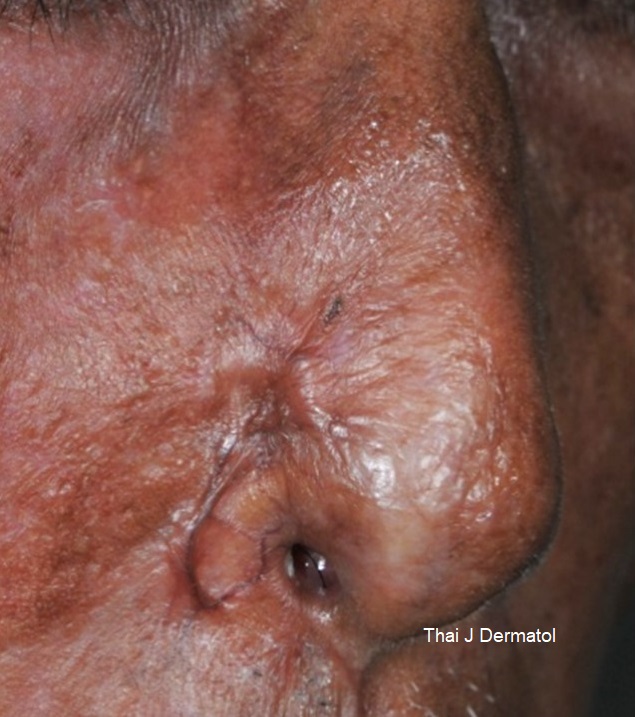A progressive cicatricial plaque on the face with nasal destruction, an uncommon presentation of chromoblastomycosis
Keywords:
Subcutaneous mycoses, Chromoblastomycosis, Fonsecaea spp., Fonsecaea nubica, CicatricialAbstract
Chromoblastomycosis is a chronic subcutaneous fungal infection caused by dematiaceous fungi. It is normally found in soil, decayed plants and woods especially at tropical and subtropical regions. It commonly occurs in male agricultural workers who were inoculated with the organism via contaminated thorns or wood splinters. We reported a case of 70-year-old man who presented with progressive cicatricial plaque at right ala of the nose associated with nasal destruction. Diagnosis was made by using polymerase chain reaction (PCR) technique and reported Fonsecaea nubica. In Thailand, no evidence of this species has been reported. The patient’s clinical symptoms were responded to oral itraconazole after 6-month course of treatment.
References
2. Queiroz-Telles F, De Hoog S, Santos DWCL, et al. Chromoblastomycosis. Clin Microbiol Rev 2017; 30: 233-76.
3. Queiroz-Telles F, Esterre P, Perez-Blanco M, Vitale RG, Salgado CG, Bonifaz A. Chromoblastomycosis: an overview of clinical manifestations, diagnosis and treatment. Med Mycol 2009 ; 47: 3-15.
4. Krzysciak PM, Pindycka-Piaszczynska M, Piaszczynski M. Chromoblastomycosis. Postepy Dermatol Alergol 2014; 31: 310-21.
5. McDaniel P, Walsh DS. Chromoblastomycosis in Western Thailand. Am J Trop Med Hyg 2010; 83: 448.
6. Nakamura T, Grant JA, Threlkeld R, Wible L. Primary Chromoblastomycosis of the Nasal Septum. Am J Clin Pathol 1972; 58: 365-70.
7. Granato L, Gonçalves ÍRD, Barrese TZ, Takara CK. Primary chromohifomycosis of the nasal septum. Braz J Otorhinolaryngol 2014; 80: 86-7.
8. Najafzadeh MJ, Gueidan C, Badali H, Van Den Ende AHGG, Xi L, De Hoog GS. Genetic diversity and species delimitation in the opportunistic genus Fonsecaea. Med Mycol 2009; 47: 17-25.
9. Ungpakorn R. Mycoses in Thailand: current concerns. Jpn J Med Mycol 2005; 46: 81-6.
10. Najafzadeh MJ, Sun J, Vicente V, Xi L, Van Den Ende AHGG, De Hoog GS. Fonsecaea nubica sp. nov, a new agent of human chromoblastomycosis revealed using molecular data. Med Mycol 2010; 48: 800-6.
11. Fransisca C, He Y, Chen Z, Liu H, Xi L. Molecular identification of chromoblastomycosis clinical isolates in Guangdong. Med Mycol 2017;55:851-8.
12. Deng S, Tsui CKM, Gerrits van den Ende AHG, et al. Global Spread of Human Chromoblastomycosis Is Driven by Recombinant Cladophialophora carrionii and Predominantly Clonal Fonsecaea Species. PLoS Negl Trop Dis 2015; 9: 1-15.
13. Tuffanelli L, Milburn PB. Treatment of chromoblastomycosis. J Am Acad Dermatol 1990; 23: 728-32.
14. Yang YP, Li W, Huang WM, Zhou Y, Fan YM. Chromoblastomycosis caused by Fonsecaea: clinicopathology, susceptibility and molecular identification of seven consecutive cases in southern China. Clin Microbiol Infect 2013; 19: 1023-8.

Downloads
Published
How to Cite
Issue
Section
License
เนื้อหาและข้อมูลในบทความที่ลงตีพิมพ์ในวารสารโรคผิวหนัง ถือเป็นข้อคิดเห็นและความรับผิดชอบของผู้เขียนบทความโดยตรงซึ่งกองบรรณาธิการวารสาร ไม่จำเป็นต้องเห็นด้วย หรือร่วมรับผิดชอบใดๆ
บทความ ข้อมูล เนื้อหา รูปภาพ ฯลฯ ที่ได้รับการตีพิมพ์ในวารสารโรคผิวหนัง ถือเป็นลิขสิทธิ์ของวารสารฯ หากบุคคลหรือหน่วยงานใดต้องการนำทั้งหมดหรือส่วนหนึ่งส่วนใดไปเผยแพร่ต่อหรือเพื่อกระทำการใดๆ จะต้องได้รับอนุญาตเป็นลายลักอักษรจากบรรณาธิการวารสารโรคผิวหนังก่อนเท่านั้น


